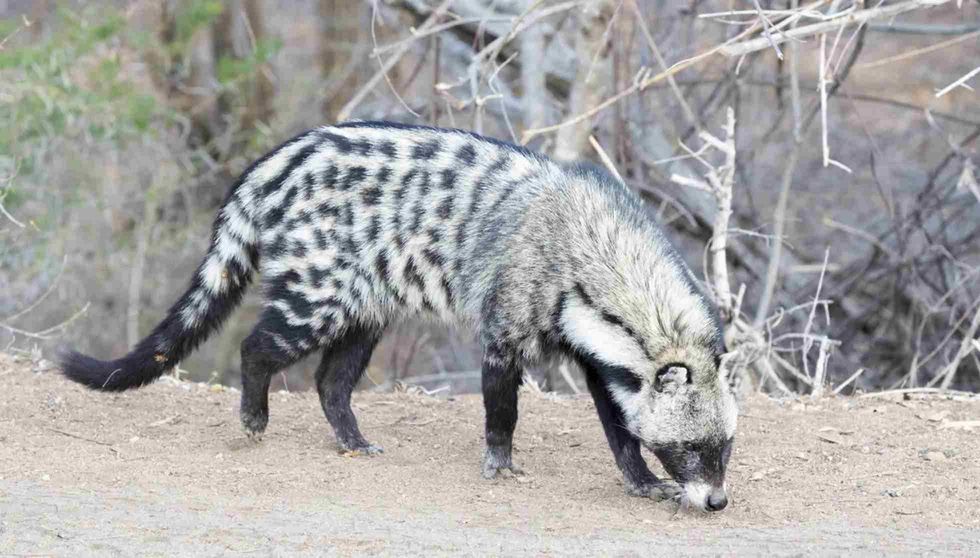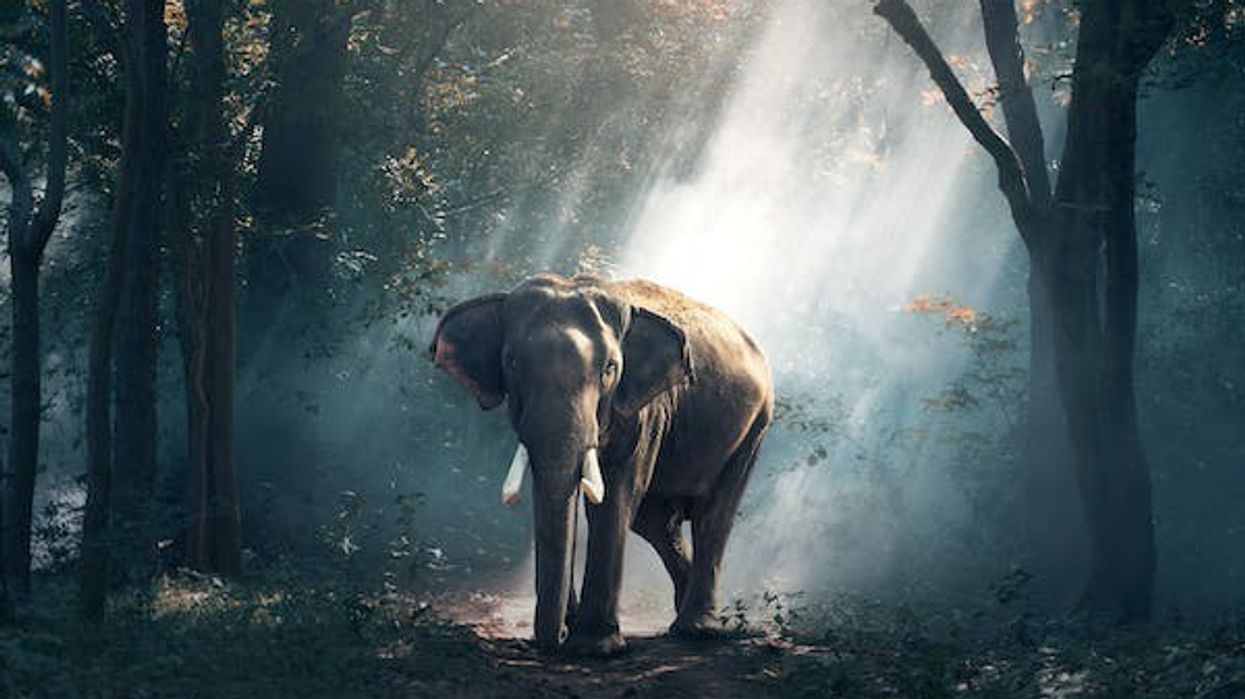Are you ready to learn about an animal that has given us several perfume products? Yes, we are talking about the African civets.
African civets or Civettictis civetta are medium-sized mammals found in Sub-Saharan Africa. They like to hunt before the sun rises and they lurk in the long grasses and bushes.
These civets have a behavior that is closer to cats, but they look quite similar to raccoons. The young civets look quite cute, and they get independent from their parents in just two months after birth. The musk produced by the African civet has been a coveted thing for humans for a long time.
Even the famous Chanel No 5 perfume used to have musk sourced from African civets. The prolific hunting of African civets still goes on even though similar synthetic substances are available.
However, they are listed as Least Concern in the IUCN Red List. We should all be more aware of these interesting animals to bring them closer to us, so read on to learn more.
If you find the African Civet facts interesting, check out our articles on quoll and Fennec fox.
African Civet Interesting Facts
What type of animal is an African Civet?
An African Civet (Civettictis civetta) is a large viverrid (small to large mammals) that are mainly found in different regions of Sub-Saharan Africa.
What class of animal does an African Civet belong to?
An African civet belongs to the class Mammalia and falls under the genus Civettictis.
How many African Civets are there in the world?
As African civets are found extensively throughout Africa, not much research has been done about their total numbers. However, a study estimated done in 2006 estimated that about 9,400 African civets are hunted in Nigeria every year.
Where does an African Civet live?
African civets are native to Sub-Saharan African. In Africa, their population is distributed among the countries of Somalia, Senegal, Namibia, South Africa, Botswana, Zanzibar, and many others. They have a varied habitat, but you will mostly find them in secondary forests, woodlands, savannahs, and near water sources such as rivers.
What is an African Civet's habitat?
African civets like to live near water sources, and they are seldom found in arid regions. Though they are frequently found in forests and in between tall grasses, some even live in the open country.
African civets have a peculiar way of dropping their excrement in large piles, and they are called latrines or civetries. Most African civets are found living within 100 m of these latrines. African civets are nocturnal animals, but they can come out on cloudy days during the daytime or afternoons.
The species has a secretive lifestyle, so not much is known about their habitat. They do avoid arid regions because of their lack of ground cover where they like to hide.
Who do African Civets live with?
African civets are solitary animals, so you will seldom find them in groups. They tend to come together only during the mating season.
African civets are well-known for their perineal gland secretions known as civetone which is used to make perfumes. The secretion produced by the glands comes in handy to an African civet to mark their territory. They spread the smell by rubbing their underbelly on different objects.
How long does an African Civet live?
The average lifespan of an African civet (Civettictis civetta) is 15–20 years.
How do they reproduce?
African civets go through an estrous (heat) cycle, usually during the months of October and November in South Africa or between March and October on the East Coast. However, African civets that are brought up in captivity have polyestrous (multiple heat) cycles.
African civets like to make their nest in dense vegetation areas, and they also use nests or dens made by other animals. The babies are born with short and dark fur.
The cubs also are able to crawl at birth. The African civet young usually leave the nest after 18 days of birth.
The young civets are fully weaned from their mother's milk after two months from birth. The young cubs' strong hind legs aid them to crawl at birth to drink their mother's milk and explore the outside as early as possible.
What is their conservation status?
According to the IUCN Red List African Civets fall under the category of Least Concern.
African Civet Fun Facts
What do African Civets look like?
Even though African civets are often called an African civet cat, they are far from looking like cats. An African civet is closer to an animal like the mongoose.
The African civet looks more like a raccoon, especially due to its multicolored fur. The animals have short fur all over the body. The color can vary between black, brown, yellow, and white.
The midsection of their body usually has some spots, which are arranged in rows. The black-brown color of their fur helps them to camouflage in the tall grasses of Africa.
Similar to raccoons, the African civet has black circles around their eyes. The civets have five digits in their paws with non-retractable claws.
The animals do have cat-like hind legs and a long fur-covered tail. A black line usually runs down from their head to the tail. One of the most striking features of an African civet is its perineal glands.
Both the male and the female of the species have musk-producing glands which help them to communicate. In the species, the perineal glands are found near their external genitalia.

How cute are they?
The cuteness of an animal is quite subjective. However, the cat-like attitude of an African civet along with their raccoon-like look does make them quite cute. That said, children may find them a little scary.
How do they communicate?
The perineal glands help an African civet to communicate with its species. Their bodies produce a unique musk that they rub on objects to mark their territory or invite mates.
Humans also love the musk as it makes an excellent component for expensive perfumes. These animals can also make three types of sound for communication: a growl, a scream, and a cough-spit. Sometimes their noise sounds like a 'ha ha ha' laughter.
How big is an African Civet?
An African civet can grow up to have an average body length of 26-33 in (67-84 cm). Their shoulder height is around 16 in or 40 cm. They are similar to the size of a large Indian civet, but they are 0.5 times bigger than the Asian palm civets as well as an African palm civet.
How fast can an African Civet move?
African civets are known for their slow gait and tend to take rest quite frequently. As they have a secretive lifestyle not much is known about the average speed of these species.
How much does an African Civet weigh?
The average weight of an African civet is around 15-44 lb (7-20 kg). The females tend to be a tad smaller compared to the male members of their family.
What are their male and female names of the species?
There are no distinct names for the male and female of the species.
What would you call a baby African Civet?
A baby African civet is called a pup. The pups are able to crawl from birth.
What do they eat?
African civets cats are omnivores, so they eat a range of things. They are also known for tolerating poisonous foods. Common foods include rodents, amphibians, small reptiles, insects, eggs, fruits, and berries.
Are they dangerous?
Well, as wild solitary animals they are most likely to behave aggressively when they meet a stranger. However, in the natural habitat of Africa, the African civet has a calm personality and their behavior is quite amiable.
Would they make a good pet?
No, it isn't legal to keep an African civet pet. However, these animals are often caught in the wild by humans as a way to get their musk. Even though the cruel practice has come under the radar, it hasn't been stopped yet. Many young civets are kept alive in horrible conditions to extract their musk.
Did you know...
An African civet can produce about 0.14 oz or 4 g of musk per week.
An African civet has 40 teeth, having 10 in each quadrant.
The patterns found on the body of an African civet are unique to each one of them.
Survival techniques of the African Civet
One of the interesting facts about the African civet is that they have the ability to fluff up their dorsal crest to look bigger as a response to being threatened. This behavior makes them look a tad bit cuter to us but is intended to intimidate. African civets are good swimmers and they mostly hunt during the night.
Different types of Civet Cat
There are several different civet cats found all over the world. Even African civets were classified into six subspecies. However, they are the only civets present in the Civettictis genus.
If we take civets in general, the nocturnal mammal is predominantly found in Asia and Africa's tropical areas. More than twelve species of civets currently exist in this world.
All of them share a cat-like appearance and the ability to produce glandular secretion or musk. Scientists have an ongoing debate about which animals can be termed as a civet. Another commonly found civet in Sub-Saharan Africa is the African palm civet.
Here at Kidadl, we have carefully created lots of interesting family-friendly animal facts for everyone to discover! Learn more about some other mammals including masked palm civet, or plains zebra.
You can even occupy yourself at home by drawing one on our African civet coloring pages.










